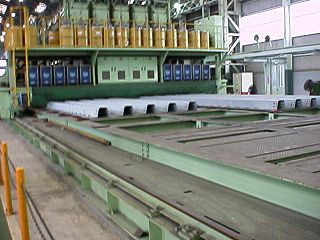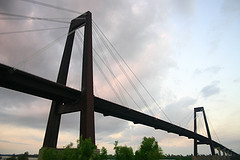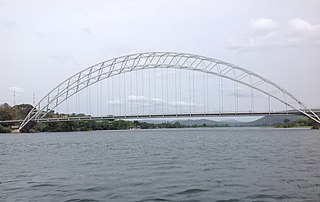Related Research Articles

A bridge is a structure built to span a physical obstacle without blocking the way underneath. It is constructed for the purpose of providing passage over the obstacle, which is usually something that is otherwise difficult or impossible to cross. There are many different designs of bridges, each serving a particular purpose and applicable to different situations. Designs of bridges vary depending on factors such as: the function of the bridge, the nature of the terrain where the bridge is constructed and anchored, and the material used to make it and the funds available to build it.

The Bronx–Whitestone Bridge is a suspension bridge in New York City, carrying six lanes of Interstate 678 over the East River. The bridge connects Throggs Neck and Ferry Point Park in the Bronx, on the East River's northern shore, with the Whitestone neighborhood of Queens on the southern shore.
The National Bridge Inventory (NBI) is a database, compiled by the Federal Highway Administration, with information on all bridges and tunnels in the United States that have roads passing above or below. This is similar to the grade crossing identifier number database compiled by the Federal Railroad Administration which identifies all railroad crossings. This bridge information includes the design of the bridge and the dimensions of the usable portion. The data is often used to analyze bridges and judge their conditions. The inventory is developed with the purpose of having a unified database for bridges to ensure the safety of the traveling public as required by the Federal-Aid Highway Act of 1968. It includes identification information, bridge types and specifications, operational conditions, bridge data including geometric data and functional description, and inspection data. Any bridge more than 20 feet long used for vehicular traffic is included.

An orthotropic bridge or orthotropic deck is typically one whose fabricated deck consists of a structural steel deck plate stiffened either longitudinally with ribs or transversely, or in both directions. This allows the fabricated deck both to directly bear vehicular loads and to contribute to the bridge structure's overall load-bearing behaviour. The orthotropic deck may be integral with or supported on a grid of deck framing members, such as transverse floor beams and longitudinal girders. All these various choices for the stiffening elements, e.g., ribs, floor beams and main girders, can be interchanged, resulting in a great variety of orthotropic panels.

High Bridge is a railroad bridge crossing the Kentucky River Palisades, that rises approximately 275 feet from the river below and connects Jessamine and Mercer counties in Kentucky. Formally dedicated in 1879, it is the first cantilever bridge constructed in the United States. It has a three-span continuous under-deck truss used by Norfolk Southern Railway to carry trains between Lexington and Danville. It has been designated as a National Civil Engineering Landmark.

The Hale Boggs Memorial Bridge is a cable-stayed bridge over the Mississippi River in St. Charles Parish, Louisiana. It is named for the late United States Congressman Hale Boggs. The bridge was dedicated by Governor David C. Treen and Bishop Stanley Ott of Baton Rouge and opened to traffic on October 6, 1983 connecting Louisiana Highway 18 on the West Bank and Louisiana Highway 48 on the East Bank. The dedication even featured a Louisiana political prank. During Governor David Treen's address, an airplane flew over the site with a trailing banner emblazoned with "Edwards Did It", a nod to the fact that much of the bridge's construction took place during the terms of 4-time Louisiana Governor, Edwin W. Edwards. The Hale Boggs Bridge was the third major cable-stayed bridge in the United States after the 1,255-foot John O'Connell Bridge of Sitka, Alaska and the Pasco-Kennewick Bridge or Ed Hendler Bridge in Washington.

The Papineau-Leblanc Bridge was one of the first cable-stayed spans in North America. It is part of Quebec Autoroute 19 and is one of the connections between Laval and Montreal, Quebec, Canada, spanning Rivière des Prairies. It was fabricated from weathering steel and has an orthotropic deck. The freeway ends abruptly at the southern end of the bridge at the intersection of Henri Bourassa Boulevard, where Autoroute 19 follows Avenue Papineau down to Quebec Autoroute 40.

The Salford Quays lift bridge, also known as the Salford Quays Millennium footbridge or the Lowry bridge, is a 91.2-metre (299 ft) long vertical lift bridge spanning the Manchester Ship Canal between Salford and Trafford in Greater Manchester, England. The pedestrian bridge, which was completed in 2000, is near the terminus of the ship canal at the old Manchester Docks. It is sited beside The Lowry theatre and gallery and links Salford Quays and MediaCityUK to Trafford Wharf and the Imperial War Museum North. It has a lift of 18 metres (59 ft), allowing large watercraft to pass beneath.

The Sunniberg Bridge is a curved multi-span extradosed road bridge with low outward-flaring pylons above the roadway edges, designed by Christian Menn and completed 1998. It carries the Klosters bypass road 28 across the Landquart River near the village of Klosters in the canton of Grisons in eastern Switzerland. It is notable because of its innovative design and aesthetically pleasing appearance sensitive to its surroundings.
Dan Mircea Frangopol is an American civil engineer and the inaugural holder of the Fazlur R. Khan Endowed Chair of Structural Engineering and Architecture at Lehigh University, Bethlehem, Pennsylvania.
The Eigensystem realization algorithm (ERA) is a system identification technique popular in civil engineering, in particular in structural health monitoring. ERA can be used as a modal analysis technique and generates a system realization using the time domain response (multi-)input and (multi-)output data. The ERA was proposed by Juang and Pappa and has been used for system identification of aerospace structures such as the Galileo spacecraft, turbines, civil structures and many other type of systems.

The Adomi Bridge is a latticed steel arch suspension bridge crossing the Volta River at Atimpoku in Ghana in West Africa. It is the first permanent bridge to span the Volta River, which drains south into the Gulf of Guinea, and is Ghana's longest suspension bridge. It provides the main road passage, just south of the Akosombo Dam, between the Eastern Region and the Volta Region of Ghana. It was opened in 1957 by Kwame Nkrumah, Ghana's first president. The iconic crescent-shaped arch bridge is featured in Ghanaian stamps and currency.

Structural integrity and failure is an aspect of engineering that deals with the ability of a structure to support a designed structural load without breaking and includes the study of past structural failures in order to prevent failures in future designs.
Paul Grundy was an eminent Australian engineer, who worked in the fields of structural and civil engineering, and was a long-standing lecturer and professor emeritus in the Department of Civil Engineering at Monash University.
Lumped damage mechanics or LDM is a branch of structural mechanics that is concerned with the analysis of frame structures. It is based on continuum damage mechanics and fracture mechanics. It combines the ideas of these theories with the concept of plastic hinge LDM can be defined as the fracture mechanics of complex structural systems. In the models of LDM, cracking or local buckling as well as plasticity are lumped at the inelastic hinges. As in continuum damage mechanics, LDM uses state variables to represent the effects of damage on the remaining stiffness and strength of the frame structure. In reinforced concrete structures, the damage state variable quantifies the crack density in the plastic hinge zone; in unreinforced concrete components and steel beams, it is a dimensionless measure of the crack surface; in tubular steel elements, the damage variable measures the degree of local buckling The LDM evolution laws can be derived from continuum damage mechanics or fracture mechanics. In the latter case, concepts such as the energy release rate or the stress intensity factor of a plastic hinge are introduced. LDM allows for the numerical simulation of the collapse of complex structures with a fraction of the computational cost and human effort of its continuum mechanics counterparts. LDM is also a regularization procedure that eliminates the mesh-dependence phenomenon that is observed in structural analysis with local damage models. In addition, LDM method has been implemented in the finite element analysis of crack propagation of steel beam-to-column connections subjected to ultra-low cycle fatigue.

Ahsan Kareem is the Robert M. Moran Professor of Engineering in the Department of Civil & Environmental Engineering and Earth Sciences (CEEES) at the University of Notre Dame. He is Director of the Nathaz Modeling Laboratory and served as the past Chair at the Department of CEEES at the University of Notre Dame. He currently serves as the President of the International Association for Wind Engineering. He was also the former President of the American Association for Wind Engineering. His fundamental contributions to aerodynamics and aeroelasticity has led to advances in the analysis, design and performance assessment of tall buildings and long span bridges. He has conducted from wind tunnel modeling to stochastic and CFD based simulations and finally to the full-scale monitoring of some of the signature buildings around the world including more recently Burj Khalifa. It utilizes a novel “SmartSync” system featuring “Internet-of-Things” (IoT) concept with built in layers of intelligence for data management and analysis. He has advanced models for damping in tall buildings and motion mitigation devices like tuned liquid dampers from design, prototype testing to post installation monitoring in buildings in the US and in the Pacific-rim. His contributions towards database assisted design through a web-portal recommended in ASCE 7 is used worldwide for designing tall buildings. More recently, his group has embarked on shape optimization of tall buildings based on CFD with embedded topology optimization to configure efficient and optimal structural system for super tall buildings and long span bridges.

R. Cengiz Ertekin is a professor of Marine Hydrodynamics and Ocean Engineering. He currently holds a guest professor position at Harbin Engineering University of China. He is best known for his contributions to the development of nonlinear water wave theories, hydroelasticity of very large floating structures (VLFS), wave energy, and tsunami and storm impact on coastal bridges. He is also the co-developer, along with Professor H. Ronald Riggs of the University of Hawaii, of the computer program HYDRAN for solving linear fluid-structure interaction problems of floating and fixed bodies.
Buckland & Taylor Ltd was a Canadian structural engineering firm specializing in bridge design and also research and building code development. It was founded in 1972 by Peter G. Buckland and Peter R. Taylor. Both had had experience with the design of major bridges. The firm continued until it was merged into COWI North America, a subsidiary of COWI A/S of Denmark, in 2015.
Franz-Josef Ulm is a Structural Engineer, an Engineering Scientist and a Professor since 1999. He is Professor of Civil & Environmental Engineering at the Massachusetts Institute of Technology (MIT), the Faculty Director of the Concrete Sustainability Hub (CSHub@MIT). He is credited for discovering the nanogranular structure of Calcium-Silicate-Hydrates (C-S-H), the binding phase of concrete, and for the development of concepts of nanoengineering of concrete which combine advanced nanomechanics experiments with molecular simulation results. He speaks up for an environmental sustainable engineering, with “greener” concrete with lower CO
2 footprint, to reduce the carbon footprint of concrete; to enhance concrete's resilience; and reduce its impact on global warming.
Ducol or "D"-steel is the name of a number of high-strength low-alloy steels of varying composition, first developed from the early 1920s by the Scottish firm of David Colville & Sons, Motherwell.
References
- 1 2 3 4 5 6 "John W. Fisher PhD, PE, NAE". Marquis WhoWho's Milestones.
- ↑ National Research Council (U.S.). Highway Research Board (1961). Special Report - Highway Research Board. The Board.
- 1 2 3 4 5 6 7 "John W. Fisher". P.C. Rossin College of Engineering and Applied Science, Lehigh University.
- ↑ "Dr. John W. Fisher". National Academy of Engineering.
- ↑ "John W. Fisher". The Franklin Institute Awards.
- ↑ "Award of Merit". International Association for Bridge and Structural Engineering (IABSE).